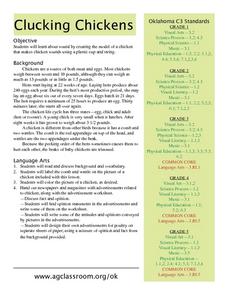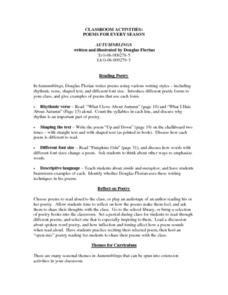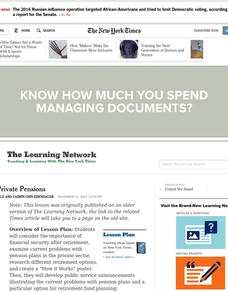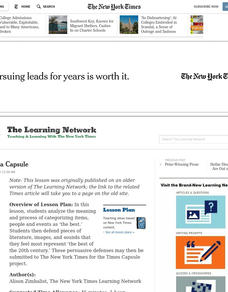Curated OER
Chinese Instruments
Learners explore Chinese instruments. In this Chinese instrument music lesson plan, students listen to a performance by Liu Fang and describe the sounds they hear. Learners classify western and Chinese instruments according to their...
Curated OER
Applied Science -Physics (2B) Pre Lab
Second graders look at different types of energy. In this energy lesson, 2nd graders define energy and the difference between kinetic and potential energy. They see examples with falling books and a slinky.
Curated OER
Assembling the News
Eighth graders decide on which pictures and sounds to use to make their story come to life. They discover copyright rules pertaining to photographs and how to make a story come to life. They complete edits on their work to make sure all...
Curated OER
Themes to Encourage Awareness of Environmental Changes on the Shoreline of Connecticut in Elementary School Students: The Case of Kelsey Island
Students begin the lesson by developing a map of Kelsey Island by following specific instructions. In groups, they are given a block of ice in which they tie a rope around and drag over various rocks for different distances. They...
Curated OER
Clucking Chickens
A comb, wattle, and beak are three characteristics that describe a chicken. Your class can explore the life of a chicken through reading, art, movement, and music. Using a plastic cup and string, they'll create a pretend chicken that...
Curated OER
Ear Gongs
Students create ear gongs and experiment with the sounds they make. In this ear gongs lesson, students understand the path of sound. Students experiment with a coat hanger to cause vibrations.
Curated OER
Aesthetics and Affect in Music from Around the World
Students explore traditional music of different societies around the world by listening to number of different musical recordings, discuss how music makes them feel, examine how music is central to cultural traditions, and compose short...
Curated OER
Poems for Every Season
Students read and explore autumn poetry. In this poetry lesson, students read Autumnblings and are introduced to different poetic forms. Lesson includes ideas for exploring the poetic forms presented in the book and cross-curricular...
Curated OER
Saving Private Pensions
Young scholars consider the importance of financial security after retirement, examine current problems with pension plans in the private sector, research different retirement options, and create a "How it Works" poster.
Curated OER
Cuisine Art
Students explore the history of the foods of different ethnic groups and the significance of these foods in perpetuating culture.
Curated OER
Fin, Feathers, or Fur?
Students learn how to classify animals. In this animal characteristics instructional activity, students read Granddad's Animal Alphabet Book, brainstorm a list of different kinds of animals, and determine their characteristics; fur,...
Curated OER
Digging for Dirt
Students examine how trash is removed and evaluate statistics related to trash removal. In this trash removal lesson, students explore the different methods of trash removal and make an original diagram graphing statistical information....
Curated OER
Dinosaurs 1: Where Are the Dinosaurs?
Students study dinosaurs. In this dinosaur lesson, students watch a web based video about dinosaurs before discussing what they liked about the dinosaurs, telling about the sounds they heard, and explaining what the Earth looked like....
Curated OER
What is Timbre?
Students analyze the differences in similar songs. In this music appreciation lesson, students discover the meaning of timbre and how it can drastically change similar pieces of music. Students sing two pieces of music with...
Curated OER
Applied Science - Physics (5A) Pre Lab
Fifth graders look at different types of waves. In this wave lesson, 5th graders find the difference and similarities of electromagnetic and physical waves. They review the components of waves such as crest, trough, wavelength, and wave...
Curated OER
Time in a Capsule
Students analyze the meaning and process of categorizing items, people and events as 'the best.' students then defend pieces of literature, images, and sounds that they feel most represent 'the best of the 20th century.'

















